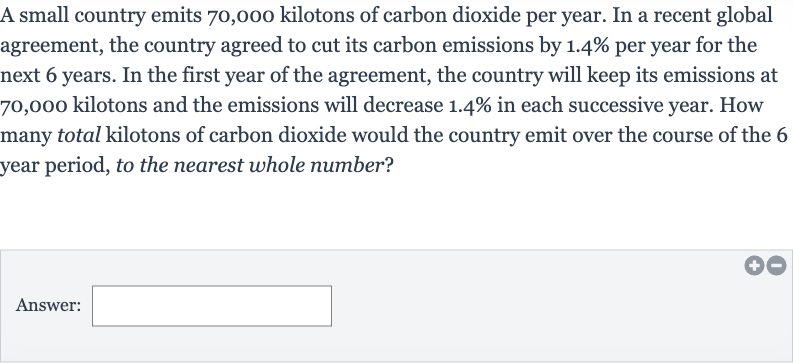AI tutor
Welcome to Bytelearn!
Let’s check out your problem:

A small country emits , kilotons of carbon dioxide per year. In a recent global agreement, the country agreed to cut its carbon emissions by per year for the next years. In the first year of the agreement, the country will keep its emissions at , kilotons and the emissions will decrease in each successive year. How many total kilotons of carbon dioxide would the country emit over the course of the year period, to the nearest whole number?Answer:
Full solution
Q. A small country emits , kilotons of carbon dioxide per year. In a recent global agreement, the country agreed to cut its carbon emissions by per year for the next years. In the first year of the agreement, the country will keep its emissions at , kilotons and the emissions will decrease in each successive year. How many total kilotons of carbon dioxide would the country emit over the course of the year period, to the nearest whole number?Answer:
- Understand the problem: Understand the problem.We need to calculate the total carbon emissions over years, with a reduction each year after the first year.
- Calculate each year: Calculate the emissions for each year.The initial emission is kilotons. For each subsequent year, we multiply the previous year's emissions by to account for the reduction.
- First year emissions: Calculate the emissions for the first year.In the first year, the emissions are kilotons since there is no reduction.
- Second year emissions: Calculate the emissions for the second year.For the second year, we multiply the first year's emissions by to find the reduced emissions. kilotons.
- Third year emissions: Calculate the emissions for the third year.For the third year, we multiply the second year's emissions by . kilotons.
- Fourth year emissions: Calculate the emissions for the fourth year.For the fourth year, we multiply the third year's emissions by . kilotons.
- Fifth year emissions: Calculate the emissions for the fifth year.For the fifth year, we multiply the fourth year's emissions by . kilotons.
- Sixth year emissions: Calculate the emissions for the sixth year.For the sixth year, we multiply the fifth year's emissions by . kilotons.
- Add up total emissions: Add up the emissions for all years to get the total emissions.Total emissions = (first year) + (second year) + (third year) + (fourth year) + (fifth year) + (sixth year).Total emissions kilotons.
- Round total emissions: Round the total emissions to the nearest whole number.Total emissions kilotons.
More problems from Exponential growth and decay: word problems
QuestionGet tutor help
QuestionGet tutor help
QuestionGet tutor help
QuestionGet tutor help
QuestionGet tutor help
QuestionGet tutor help
QuestionGet tutor help
QuestionGet tutor help
QuestionGet tutor help
